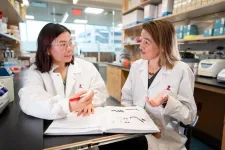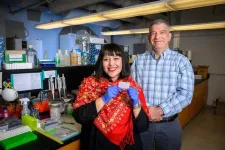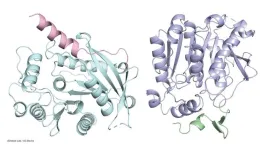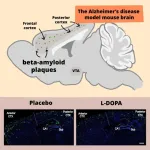(Press-News.org) Outbreaks of hand, foot and mouth disease (HFMD), which causes fever and rash in young children, typically occur in the summer months. Similarly, historic cases of polio were observed in the summer months in the United States. Both diseases are caused by different species of enteroviruses, a large genus of RNA viruses. However, the drivers of the seasonal patterns of these diseases have remained somewhat unclear.
A common set of drivers can explain the timing of outbreaks of both HFMD and polio according a recent study by researchers at Brown University, Princeton University and Johns Hopkins, published on July 31 in Nature Communications. Further, these summertime outbreaks may hint at implications for climate change.
“We find, even after controlling for other factors, that temperature appears to increase enterovirus transmission,” said first author Rachel Baker, the John and Elizabeth Irving Family Assistant Professor Climate and Health at Brown University. “Crucially, we see a similar sized effect for polio historically, and more recent enteroviruses serotypes that cause HFMD.”
“Enterovirus outbreaks exhibit clear patterns over space,” noted co-author Saki Takahashi, Assistant Professor of Epidemiology at Johns Hopkins University who has previously studied the outbreak dynamics of enteroviruses in both China and Japan. “At higher latitudes we see large outbreaks of HFMD every two or three years, but closer to the tropics we observe outbreaks twice a year – our results are able to capture these large scale patterns.”
Baker and co-authors used an epidemiological model to show that temperature and demographic drivers, specifically the timing of school semesters, can explain the two HFMD outbreaks a year in southern China. In more northern locations, the temperature effect dominates and the schooling effect disappears.
“What really matters is the seasonal range of climate, i.e. the maximum temperature and minimum temperature,” said co-author Wenchang Yang, Associate Research Scholar of Geosciences at Princeton University. “That might have implications for how we think about the future effects.”
The authors used their model to consider the implications of climate change for enterovirus outbreaks using output from 14 different climate models. “A key finding is the impact of variability,” said co-author Gabriel Vecchi, the Knox Taylor Professor of Geosciences and Director of the High Meadows Environmental Institute at Princeton University. “The impact of climate variability on disease dynamics is underexplored, and this study represents a clear advance in the needed exploration of this topic.”
The authors found that climate change could increase the peak size of enterovirus outbreaks by up to 40%, but effects vary by location and climate model. Improved surveillance of enterovirus circulation could help track these possible impacts: “Serological surveys are vital for tracking susceptibility to enteroviruses and other pathogens,” said Takahashi.
###
The paper, "Increasing intensity of enterovirus outbreaks projected with climate change" was published online July 31 by Nature Communications. This work was supported in part by the Cooperative Institute for Modeling the Earth System (CIMES) at Princeton University.
END
(Memphis, Tenn. – August 6, 2024) To effectively treat a disease or disorder, doctors must first know the root cause. Such is the case for developmental and epileptic encephalopathies (DEEs), whose root causes can be hugely complex and heterogeneous. Scientists at St. Jude Children’s Research Hospital demonstrated the value of DNA methylation patterns for identifying the root cause of DEEs, showing specific gene methylation and genome-wide methylation “episignatures” ...
URBANA, Ill. – Black Americans experience racial discrimination on a regular basis, and it is a cause of chronic and pervasive stress. It is known to contribute to elevated risk for poor mental health outcomes, but most research has focused on individuals. A new study from the University of Illinois Urbana-Champaign looks at the interpersonal effects of discrimination on parents and their adolescent children.
“A person’s experiences with racial discrimination are not just their own but may spill over into the ...
DETROIT — Mark Lumley, Ph.D., distinguished professor of psychology in Wayne State University’s College of Liberal Arts and Sciences, was recently awarded the 2024 Nathan W. Perry, Jr. Award for Career Service to Health Psychology from the Society for Health Psychology.
The Society for Health Psychology is a national nonprofit that seeks to improve the lives of individuals and society by promoting health, preventing illness and improving health care through research, practice, education, training and advocacy.
“I’m delighted and greatly honored for this recognition,” ...
URBANA, Ill. -- Elephant conservation is a major priority in southern Africa, but habitat loss and urbanization mean the far-ranging pachyderms are increasingly restricted to protected areas like game reserves. The risk? Contained populations could become genetically isolated over time, making elephants more vulnerable to disease and environmental change.
A recent study from the University of Illinois Urbana-Champaign and the University of Pretoria in South Africa demonstrates how African conservation managers could create and optimize elephant movement corridors across a seven-country ...
Social media’s rise to popularity between 2010 and 2020 has been strongly correlated with the nationwide freefall in youth mental health that characterized the 2010s. Lawmakers have put increasing pressure on the U.S. government to take social media regulation more seriously, with cases about platforms like Facebook, Instagram and X rising to the Supreme Court level.
But despite the ubiquity of social media, scientists at Northwestern Medicine and Ann & Robert H. Lurie Children’s Hospital of Chicago found that in Illinois, youth emergency room visits and hospitalizations for depression and anxiety decreased ...
or many plants, more branches means more fruit. But what causes a plant to grow branches? New research from the University of California, Davis shows how plants break down the hormone strigolactone, which suppresses branching, to become more “bushy.” Understanding how strigolactone is regulated could have big implications for many crop plants.
The study was published August 1 in Nature Communications.
“Being able to manipulate strigolactone could also have implications beyond plant architecture, including on a plant’s resilience to drought and pathogens,” said senior author Nitzan Shabek, an associate professor in the UC Davis Department of ...
How would you summarize your study for a lay audience?
Some proteins, such as programmed cell death protein 1 (PD1), can stop the immune system from attacking cancer cells and, therefore, support the growth of cancer. Therapies targeting these proteins can be highly effective, but tumors can become resistant.
We applied a method to detect proteins on a single–cell level to uncover human carcinoembryonic antigen cell adhesion molecule 1 (CEACAM1) patterns in melanoma. We found that increased ...
Damon Runyon Cancer Research Foundation awards $5.2 million to top clinical investigators
The Damon Runyon Cancer Research Foundation has named six new Damon Runyon Clinical Investigators. The recipients of this prestigious award are outstanding, early-career physician-scientists conducting patient-oriented cancer research at major research centers under the mentorship of the nation's leading scientists and clinicians.
The Clinical Investigator Award program was designed to increase the number of physicians capable of translating scientific discoveries into new treatments for cancer patients. Each Awardee will receive $600,000 over three years, ...
August 6, 2024 — Thoracic ossification of the posterior longitudinal ligament (TOPLL) is a rare condition associated with ectopic bone formation in the thoracic spine. A long-term follow-up study from Japan shows significant and lasting improvement in outcomes with posterior decompression and fixation surgery for patients with T-OPLL, reports The Journal of Bone & Joint Surgery. The journal is published in the Lippincott portfolio by Wolters Kluwer.
"Surgical treatment of T-OPLL is effective in improving neurological function, quality ...
A new way to combat Alzheimer’s disease has been discovered by Takaomi Saido and his team at the RIKEN Center for Brain Science (CBS) in Japan. Using mice with the disease, the researchers found that treatment with dopamine could alleviate physical symptoms in the brain as well as improve memory. Published in the scientific journal Science Signaling on August 6, the study examines dopamine’s role in promoting the production of neprilysin, an enzyme that can break down the harmful plaques in the brain that are the ...





